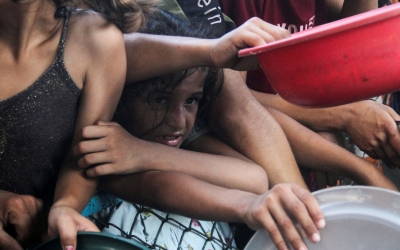Israel bans at least six medical aid missions from entering Gaza

At least six medical aid missions currently operating inside the Gaza Strip received orders this week from the Israeli government that they would no longer be allowed access to their patients in the enclave.
The World Health Organisation (WHO) made the announcement on Thursday and informed the medical groups after Israel told the UN agency about their decision through text messages.
Among those groups are Fajr Scientific, Glia, and the Palestinian American Medical Association (Pama).
The Washington Post reported that WHO said it was concerned about the impact the order would have on Gaza's strained medical system, adding that the emergency medical teams in Gaza are essential to keeping the system running, as only 17 of the 36 hospitals in Gaza remain in operation.
Israel’s coordinator of government activities in the territories (Cogat) appeared to give no reason for the decision to ban the missions from Gaza.
New MEE newsletter: Jerusalem Dispatch
Sign up to get the latest insights and analysis on Israel-Palestine, alongside Turkey Unpacked and other MEE newsletters
WHO pressed for “urgent and sustained facilitation of entry for EMTs into Gaza”, and said there has been widespread malnutrition and rampant disease across the Strip.
No food or aid of any kind has entered northern Gaza since 1 October amid a massive ground operation launched by the Israeli army.
“This is a death sentence for thousands of patients,” the International Centre of Justice for Palestinians (ICJP) said in a statement. “These organisations have, collectively, sent hundreds of medical delegates to provide life-saving aid to sick and injured Palestinians in Gaza over the past twelve months.”
The medical teams have treated over 15,000 patients since October 2023 and dispatched specialists in trauma surgery, pediatric medicine and neurosurgery, according to ICJP's statement.
The ICJP added that there may be other groups affected by this order.
The entire population of the Gaza Strip remains at risk of famine and is currently experiencing an "emergency" level of acute food insecurity, a global hunger monitoring body has said, with the situation expected to deteriorate as Israel tightens its siege on the north of the besieged Palestinian enclave.
The obstruction of humanitarian access and the intensity of the bombing campaign have significantly increased the risk of famine for residents in northern Gaza as food, water, fuel, and medical supplies dwindle.
In a new UN-backed assessment published on Thursday, the Integrated Food Security Phase Classification (IPC) said around 1.84 million people across Gaza are living through high levels of acute food insecurity, including 133,000 people who are suffering "catastrophic" food insecurity.
The IPC, which conducted its new analysis between 30 September and 4 October, is expecting the number of people experiencing catastrophic hunger to nearly triple in the coming months.
Article fallout
Cogat’s decision comes on the heels of a New York Times guest essay published on 9 October, entitled, “65 Doctors, Nurses and Paramedics: What We Saw in Gaza.”
The piece was led by Feroze Sidhwa, a trauma surgeon with Pama, one of the organisations now barred. It also featured testimony from Mimi Syed, an emergency physician who is also a Pama volunteer.
The harrowing piece described in detail a pattern of paediatric patients who were shot in the head - suggesting that children were directly targeted by Israeli soldiers.
It also highlighted the magnitude of the burns and wounds other children suffered, adding that few had any psychiatric help at all.
Soon after publishing the essay, The New York Times found itself under attack and having to mount a defence due to the testimonies. Critical letters sent to the paper said the essay “ignored the brutality of Hamas” and “blamed Israel”.
Other news outlets cited Israeli officials or soldiers who said the doctors’ claims - and imaging - were fabricated.
“We stand behind this essay and the research underpinning it,” New York Times opinion editor Kathleen Kingsbury wrote in a rare defence.
“Times Opinion rigorously edited this guest essay before publication, verifying the accounts and imagery through supporting photographic and video evidence and file metadata. We also vetted the doctors and nurses’ credentials,” she said.
The paper had presented the scans to independent experts who specialise in gunshot wounds, radiology and paediatric trauma, and attested to their credibility, Kingsbury said.
The paper was also in possession of the photographs of the victims described in the essay.
Those pictures, she said, “were too horrific for publication”.
With no foreign journalists allowed inside Gaza, medical professionals have been among the very few who can take what they witnessed to the outside world.
Middle East Eye delivers independent and unrivalled coverage and analysis of the Middle East, North Africa and beyond. To learn more about republishing this content and the associated fees, please fill out this form. More about MEE can be found here.





